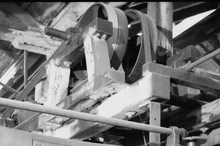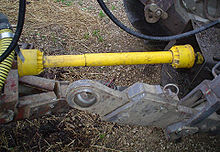- Jackshaft
-
For the locomotive component, see Jackshaft (locomotive).
A jackshaft, also called a countershaft, is a common mechanical design component used to transfer or synchronize rotational force in a machine. A jackshaft is often just a short stub with supporting bearings on the ends and two pulleys, gears, or cranks attached to it.
During the industrial revolution, the jackshaft was commonly used with the line shaft to transfer rotational power from the ceiling-mounted line-shaft to individual mechanical devices on the ground.[dubious ] A jackshaft with two belt pulleys could redirect the line-shaft belt power around an obstruction. Modern jackshafts are often hidden inside large machinery as a component of the larger overall device.
In farm equipment, a spinning output shaft on the rear of the vehicle is commonly referred to as the Power Take-Off or PTO, and the power-transfer shaft that is connected to it is commonly called a PTO shaft, but is also a jackshaft.
References
Categories:
Wikimedia Foundation. 2010.


